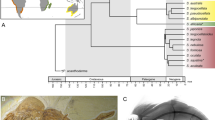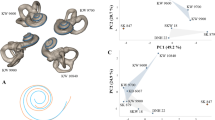Abstract
THE avian order Ciconiiformes contains a heterogeneous assemblage of long legged, long necked birds which have traditionally been classified together because of superficial resemblance. The order usually contains the storks, ibises, herons and two rather aberrant birds, the whalebill (Balaeniceps rex) and the hammerkop (Scopus umbretta), which are placed in monotypic families, the Balaencipitidae and Scopidae, respectively. The evolutionary relationships among the members of the Ciconiiformes and between this order and other living birds are little understood. Using an analysis of the morphology of the stapes (the single avian ear ossicle)1,2, I have obtained evidence for the evolutionary affinity of the whalebill with the storks, which now seem to form a monophyletic assemblage.
This is a preview of subscription content, access via your institution
Access options
Subscribe to this journal
Receive 51 print issues and online access
$199.00 per year
only $3.90 per issue
Buy this article
- Purchase on Springer Link
- Instant access to full article PDF
Prices may be subject to local taxes which are calculated during checkout
Similar content being viewed by others
References
Feduccia, A. Univ. Kansas Mus. Nat. Hist., Misc. Publ. 63 (1975).
Feduccia, A. Syst. Zool. 26, 19–31 (1977).
Cottam, P. Br. Mus. (Nat. Hist.) Zool. Bull. 5, 5–72 (1957).
Ligon, J. D. Univ. Michigan Mus. Zool. Occas. Pap. 651 (1967).
Author information
Authors and Affiliations
Rights and permissions
About this article
Cite this article
FEDUCCIA, A. The whalebill is a stork. Nature 266, 719–720 (1977). https://doi.org/10.1038/266719a0
Received:
Accepted:
Issue Date:
DOI: https://doi.org/10.1038/266719a0
This article is cited by
-
The phylogenetic affinities of the Shoebill (Balaeniceps rex)
Journal für Ornithologie (2003)
Comments
By submitting a comment you agree to abide by our Terms and Community Guidelines. If you find something abusive or that does not comply with our terms or guidelines please flag it as inappropriate.



